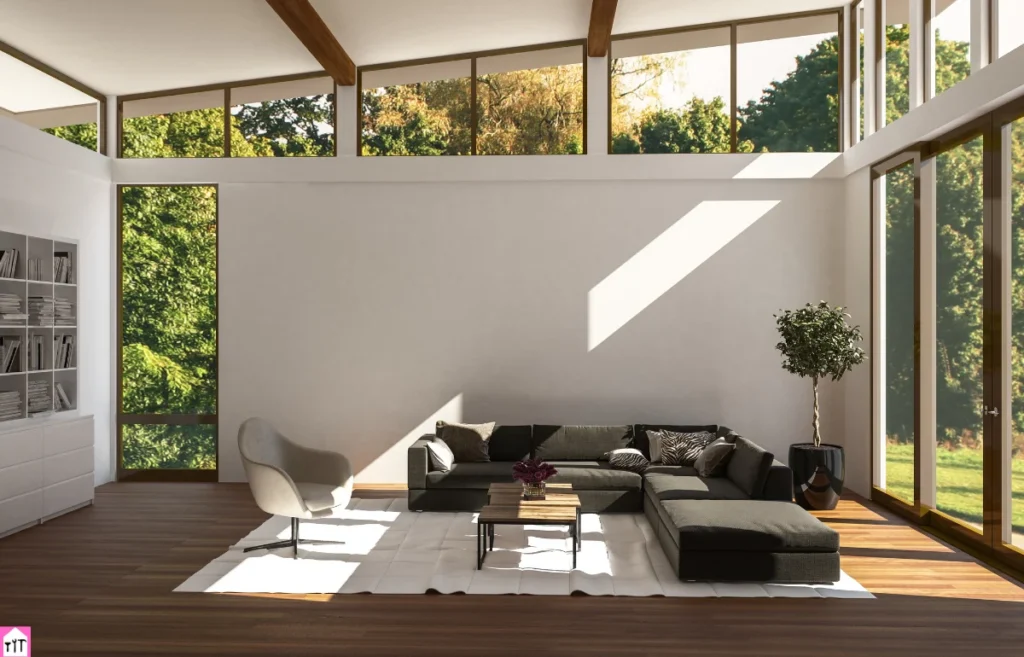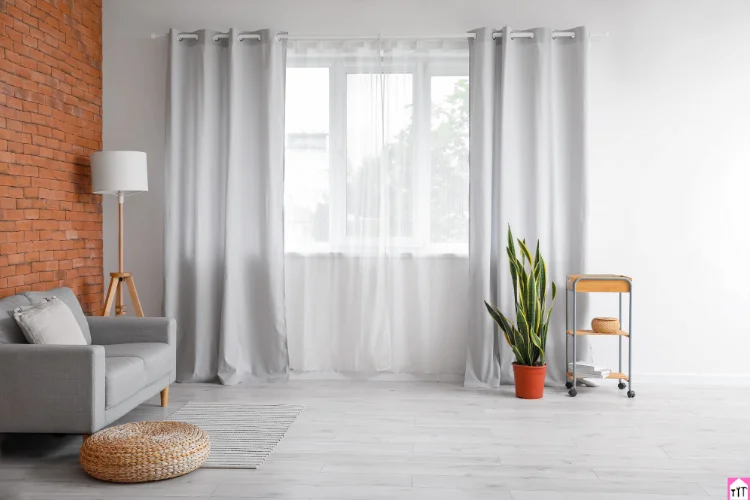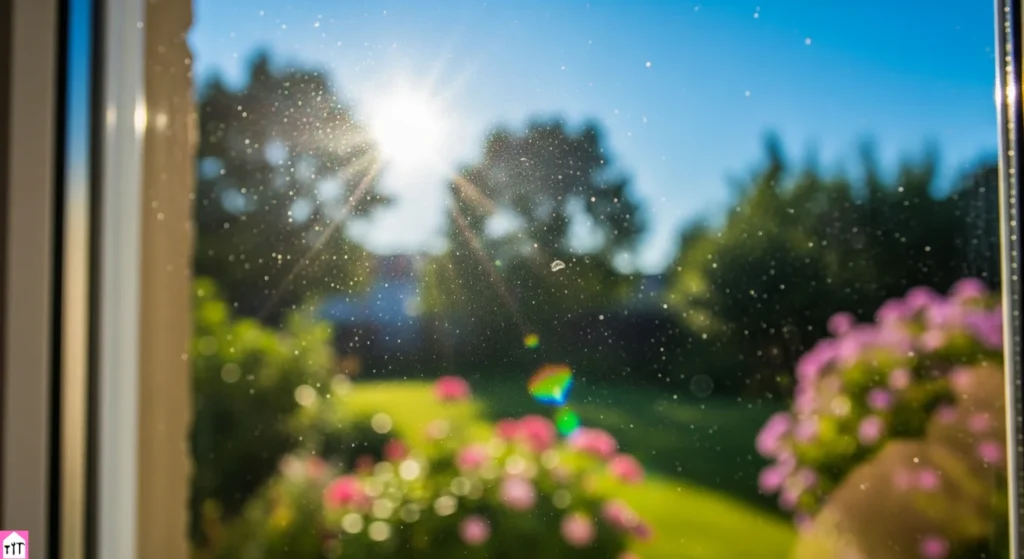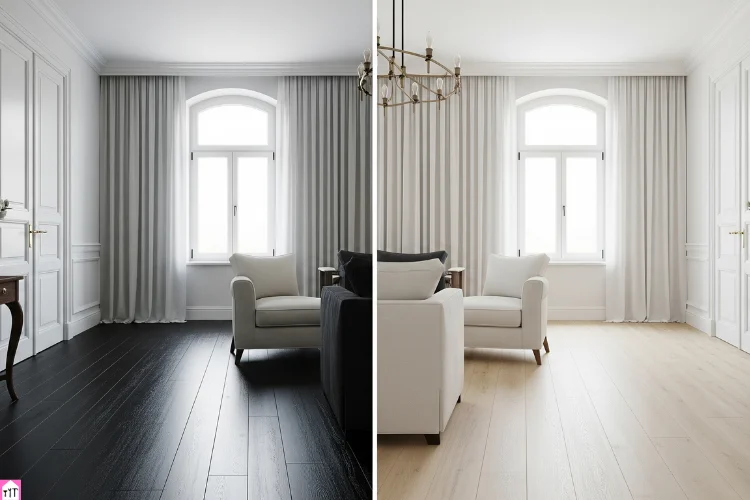
A house illuminated by natural light creates a warm and inviting atmosphere. It lifts your mood, makes spaces feel more open, and creates a sense of calm that’s hard to replicate with artificial lighting. The good news? You don’t need a full-blown extension or expensive remodelling to make it happen.
Sometimes, it’s the smaller, well-thought-out changes that can have the biggest effect.
Here are 9 simple renovation ideas our UK team recommends if you want to let more light into your home, without turning your whole house upside down.
1. Repaint in Lighter Colours to Enhance Natural Light
A lick of paint can do wonders. If your rooms are painted in darker shades, consider switching to lighter tones like soft whites, pale greys, warm creams, or pastels. These colours reflect sunlight rather than absorbing it, instantly making your space feel brighter and more spacious.
For an even bigger boost, go for a finish with a slight sheen – eggshell, satin, or semi-gloss paints bounce light around the room beautifully. And don’t forget the ceiling – a crisp white overhead helps reflect daylight from top to bottom.
2. Add Reflective Surfaces
You’d be surprised how much light a few well-placed reflective surfaces can add. Think mirrors, glass tables, metallic décor, or glossy splashbacks. Mirrors, in particular, are brilliant when placed opposite windows – they essentially double the sunlight coming into your room.
If you’ve got a darker corner or an awkwardly lit space, try hanging a large mirror there. It’s a simple design trick that adds style and brightness all at once.
3. Upgrade Your Window Dressings for More Natural Light

Heavy curtains might be cosy in winter, but they can really block out natural light. Swapping them for lighter alternatives can make a huge difference. Sheer curtains, light-filtering blinds, or Venetian blinds allow light in while still giving you some privacy.
Roller blinds in a translucent fabric are great for a clean, modern look – or you could go for a layered approach with both sheer and blackout options. Whatever you choose, the goal is to let daylight work its magic without sacrificing comfort.
4. Replace Internal Doors with Glass Versions
If your home has a lot of solid internal doors, you might be unintentionally shutting off the flow of light from one room to the next. Replacing them with glass-panel doors – or even frosted sliding doors – helps light travel more freely.
This is particularly effective between hallways and living areas or between kitchens and dining rooms. Frosted or reeded glass works well if you want to keep some privacy while still enjoying the benefits of extra brightness. Additionally, it brings a sleek and contemporary feel.
5. Add Skylights or Roof Lights
Installing a skylight is a slightly bigger job, but it can be absolutely transformative, especially in rooms that don’t get much light from traditional windows. Flat roof skylights, skylights, or roof lanterns like those from Toughened Glass Systems bring in daylight from above, flooding your space with sunshine.
They’re perfect for kitchens, lofts, bathrooms, or side extensions. A well-chosen roof light not only brightens your home but can also cut down on daytime electricity use. Opt for models with good thermal insulation so you’re not losing heat in winter or gaining too much in summer.
6. Clean and Declutter Your Windows

It might sound obvious, but sometimes the best fix is simply to give your windows a proper clean. Dust, smears, and grime can seriously reduce how much light makes it inside. Clean both the inside and outside of your windows regularly, especially after winter or bad weather.
While you’re at it, check for anything blocking light outside – like overgrown hedges, nearby garden furniture, or even flower boxes. Inside, try to keep the space around windows as open as possible. Avoid placing bulky furniture in front of them – you’ll be amazed how much brighter the room feels when the windows are clear and unobstructed.
7. Use Natural Light with Mirrored or Glass Splashbacks
Kitchens often benefit hugely from more natural light – and if you don’t want to add a new window, mirrored or glass splashbacks can be a great workaround. Installed behind the hob or sink, they reflect natural light and artificial light to brighten the whole space.
Mirrored splashbacks are especially useful if you’ve got a galley kitchen or one with limited windows. They also look sleek and modern, and are easy to keep clean. Win-win.
8. Choose Low Furniture and Open Shelving
Furniture can play a big role in how light moves through a space. Tall, bulky units tend to block light and make rooms feel darker. Swapping them out for low-profile pieces – like open shelving, low coffee tables, or sofas raised off the floor – helps create a lighter, more open layout.
Try to avoid crowding windows with wardrobes or shelving. In the kitchen, consider open shelving instead of upper cabinets to avoid boxing in the walls. It’s a subtle shift that opens up the room and lets light flow more freely.
9. Switch to Light-Toned Flooring for More Natural Light

Flooring might not be the first thing you think of when trying to boost natural light, but it can make a big difference. Dark floors tend to absorb light, while light-coloured options – such as pale oak, bleached wood, or light stone tiles – help reflect it.
Even if you’re not ready to change the floor entirely, adding a large, light-coloured rug can have a similar effect. If you have wooden floors, consider sanding and refinishing them in a lighter tone or using a semi-gloss finish for added reflectiveness.
FAQs on Natural Light
Can adding skylights affect my energy bills?
Yes – in a good way. Skylights can reduce your need for artificial lighting during the day, which can lower your electricity bills. If you choose a high-quality, thermally efficient skylight, it can also help regulate the temperature indoors, saving on heating in winter and cooling in summer. Just be sure to go for one with proper glazing and seals.
Are glass doors suitable for every room?
Glass doors work brilliantly in most parts of the home, especially in communal areas like living rooms, dining spaces, and kitchens. If you’re concerned about privacy, frosted or patterned glass is a great compromise. For bathrooms or bedrooms, reeded or tinted glass can provide the privacy you need without blocking out the light completely.
Do I need planning permission to install a skylight?
In most cases, no, especially if the skylight doesn’t protrude much from the roof and meets certain building regulations. However, if your home is listed or in a conservation area, you may need to seek permission. It’s always best to check with your local council before going ahead with any roof work.
Final Thoughts on Natural Light
Letting more natural light into your home doesn’t have to mean a full-scale renovation. With a few smart tweaks – like lighter paint, reflective surfaces, and better use of space – you can completely change how your home feels.
It’s not just about style either. Brighter homes can lift your mood, save energy, and even increase your property’s value. Whether you go big with a skylight or start small with a mirror, these little changes can have a lasting impact.
